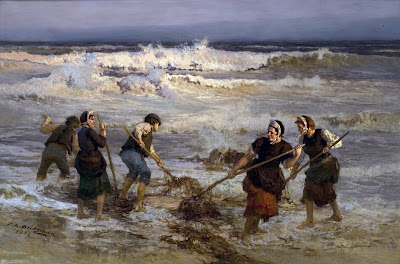
Posted on 07/15/2009 2:12:17 PM PDT by nickcarraway
All along the California coast, stretching from Los Angeles to San Francisco, a species of rapidly-growing sea kelp from Japan has begun taking over the coastline and spreading quicker than authorities can contain it.
The aggressive seaweed, known to scientists as Undaria pinnatifida, was first detected in the area in May when a local biologist noticed the marine plant clinging to piers and boats in a San Francisco Bay yacht harbor.
“I was walking in San Francisco Marina, and that's when I saw the kelp attached to a boat,” recalled Chela Zabin, a biologist at the Smithsonian Environmental Research Center in Tiburon, Calif. “It was six-foot long, and there is nothing here in the bay that gets to that size. I didn't want to believe what it was. It's depressing.”
Marine biologists had previously believed that the spread of kelp had been halted in the Monterey Bay region. As public funding for eradication efforts had run out, officials have since depended on the efforts of private volunteers to battle the pesky seaweed.
The seaweed — an edible staple, known to the Japanese known as wakame — was first spotted in Los Angeles Harbor in 2000. Within a year, the plant — capable of growing a prodigious inch a day — had spread several hundred miles northwards to Monterey Bay.
Researchers have conducted studies over the past several years revealing that the obnoxious kelp was most likely introduced accidentally by ships transporting oysters from the Far East.
On Thursday, a team of divers spent hours removing the kelp from boats, docks, pier pilings and wherever else they could find it. Scientists say it’s highly unlikely that they managed to remove it all, but have are already busy scheduling monthly check-ups to keep tabs on its expected resurgence.
“If it’s restricted to two docks in the marinas in San Francisco Bay, we’ll have a chance,” explained Zabin. “If it’s spread beyond those places, it may be a lost cause.”
Marine biologists are particularly concerned about the deleterious effects that the kelp could have on an already fragile local ecosystems. They fear that the hearty invader could potentially block sunlight to shorter, slower-growing species of native kelp on the seabed. Indigenous kelp forests provide food and protection to a variety of local marine life, including otters and hundreds of species of fish.
Because of its wide range and ability to spread quickly, Undaria pinnatifida has been included among the top 100 of the world's worst invaders, according to the Global Invasive Species Database. Though native to Japan, China and Korea, the plant has been found in places as dispersed as the Mediterranean Sea, the Atlantic Coast of Europe, Argentina and New Zealand—not to mention the Pacific coast of North America.
The National Oceanic Atmospheric Administration has been organizing volunteer divers to help weed out the tenacious plant in Monterey harbor for the past six years. While their efforts have certainly managed to curb the growth of the kelp in the region, they’ve been unable to stop it from spreading northward.
“This is not well studied enough, and we're really quite nervous about it getting out in the ecosystem,” said Zabin. “It will attach to about anything.”


It probably came from all that undigested sushi wrap Califonians are flushing down the system in the first place.
So can it be made into ethanol?
I’ll bet cows will eat it.
I love the stuff.
The seaweed — an edible staple
Leave it, we are probably going to need it.
Invaders? No problem plenty of sanctuary cities in Kalifornia.
Disclaimer: Opinions posted on Free Republic are those of the individual posters and do not necessarily represent the opinion of Free Republic or its management. All materials posted herein are protected by copyright law and the exemption for fair use of copyrighted works.